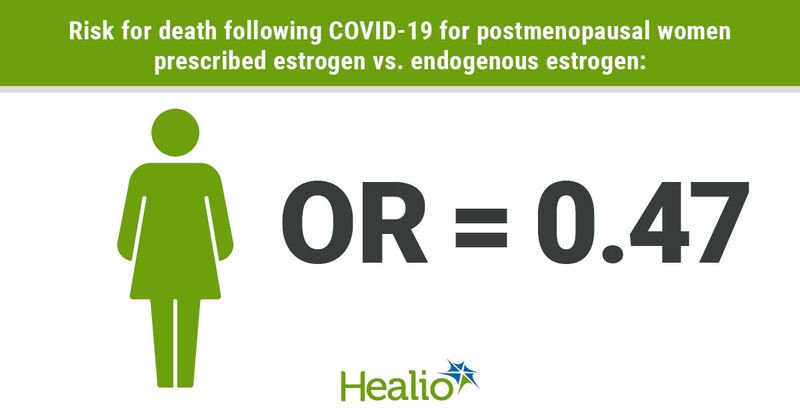Estrogen therapy halved COVID-19 death risk among postmenopausal women
Menopausal hormone therapy significantly decreased the odds of death from COVID-19 among postmenopausal women, according to data from a nationwide registry-based study.
Women appear to be protected from poor outcomes with COVID-19 when compared with men, even after adjustment for confounding risk factors, according to Malin Sund, MD, PhD, visiting professor in the department of surgical and perioperative sciences at Umea University in Sweden, and colleagues.

“This implies biological differences between the sexes in terms of sensitivity to severe COVID-19,” they wrote.
Sund and colleagues conducted the analysis to better understand the role of estrogen augmentation in post-menopausal women with COVID-19, since the hormone has been identified as a potential therapeutic candidate.
The study involved 14,685 postmenopausal women from a Swedish nationwide cohort who were aged between 50 and 80 years and had verified COVID-19. The women were divided into three groups: group 1 included 227 women previously diagnosed with breast cancer and receiving endocrine therapy (decreased systemic estrogen levels); group 2 included 2,535 women receiving menopausal hormone therapy (increased systemic estrogen levels); and a control group. Researchers adjusted for potential confounders, including age, annual disposable income, highest level of education and the weighted Charlson Comorbidity Index (wCCI).
Death after COVID-19 served as the primary outcome measure.
Results revealed that unadjusted ORs for death after COVID-19 were 2.35 (95% CI, 1.51-3.65) for group 1 and 0.45 (95% CI, 0.34-0.6) for group 2 compared with the control group. Following adjustment, only the OR for death in group 2 maintained statistical significance (0.47; 95% CI, 0.34-0.63). Moreover, the absolute risk for death was 4.6% in the control group compared with 10.1% in group 1 and 2.1% in group 2.
In other mortality data, factors associated with the risk for death from COVID-19 included older age and higher wCCI. Specifically, with every year increase in age, the OR for dying was 1.15 (95% CI, 1.14-1.17), while every increase in wCCI resulted in an OR for dying of 1.13 (95% CI, 1.10-1.16). Additionally, low income and having only a primary education also increased the odds of dying from COVID-19.
“This study shows an association between estrogen levels and COVID-19 death,” the researchers wrote. “Consequently, drugs increasing estrogen levels may have a role in therapeutic efforts to alleviate COVID-19 severity in postmenopausal women and could be studied in randomized control trials.”
The study limitations, according to the researchers, included missing information regarding compliance to pharmaceutical modulation of estrogen; unavailable information about the exact duration of the post-menopausal hormone therapy; and the lack of measuring circulating estrogen levels.

